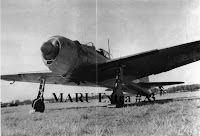And while you might have thought that the gray Kasumigaura A6M2s were puzzling, wait to see the camouflaged ones!
From 1943, the IJNAF sought to formalize the appearance of its aircraft that were receiving haphazard camouflage at unit level, and the "top green / bottom gray" pattern became official. The IJNAF schools in Japan mainland followed suit and started painting their aircraft in this pattern however they saw fit. It seems that some aircraft received a thorough overhaul and were properly repainted, other schools employed mops and brushes and the ground crews let their creativity loose.
As a result, the Kasumigaura A6M2s we introduced in the previous post, received a top coat of green paint.
Like the KA-102 we see in the photo below from the book FAOW Special #6.
Note that the green camo has been applied as low as possible on the fuselage and even under the horizontal tail surfaces.
Here's another photo of the same aircraft from the same publication attempting a landing.
Note the yellow IFF stripes and that the hinomaru under the wing do not appear to have any white surround (more about that later).
Here's a photo of a group of three Kasumigaura Zeros from the quite old publication "Nihon Kaigun Kokutai Shashin-shu" by Akimoto Minoru.
The Zero on the right is A "KA-102" which appears to have a different green camo pattern from the cockpit rearwards. In the photo above it has a Mitsubishi green camo pattern, in this photo a Nakajima. Is it the same aircraft featured in the photos above or a replacement with the same tail marking?
The Zero on the left is A "KA-104 but has Mitsubishi-like green camo pattern. There is also a thick slanted band, probably yellow, but it doesn't seem to wrap around the fuselage. The underwing hinomaru is unfortunately not clear enough.
The tail marking of the third Zero has never been deciphered.
In the older FAOW#5, the particular KA-104 has been depicted like this...
...with the artist mentioning that the undersurfaces were trainer yellow, but he has somehow forgotten to add the yellow fuselage band.
There are two more photos of this (?) KA-104 in flight, featured in the book "Zero Fighter" by Kojinsha.
The photos were taken by LDCR Yanagisawa Hachiro, whom we met in the previous post, on a return training flight from Usa in Kyushu to Kasumigaura, on March 26, 1944. During this flight, in the cockpit of KA-104 was CPO Kuga.
Note the absence of the yellow fuselage band in both photos.
Here's another photo of A KA1-04 from the book "Tatakau Zero-sen" by Watanabe Yoji.
The photo quality leaves much to be desired but again the yellow band is not visible. Watanabe mentions in the caption that the green camo seems to have extended under the wing.
Note the white surround on the underwing hinomaru and the very dark port wheel cover.
The Ka-104 has also been, horribly, depicted like this.
Very dark underside "yellow", very thin fuselage line, bad katakana KA and lettering in general.And the 2012 Model Art Profile #12 has depicted it like this
But I believe the illustration by Ibukuro Toyohiko in Gakken's "Zero-sen Perfect Guide" is much more accurate.
Putting the KA-104 A6M2 aside, let's see another intriguing photo, from FAOW#5.
The caption explains that the Zero in the foreground is A "KA-101"!!!
The author is not sure if it's the same Zero we saw in the previous post and explains that the tail marking is in red surrounded by white and that the undersurfaces are in "yellow".
The underwing hinomaru doesn't seem to have a white surround though and note the very dark IFF stripe. Compare it with the white of the hinomaru or the clothes of the ground crew member.
I'm inclined to say that it is indeed the same KA-101 we saw in the previous post with properly painted cowling, gray undersurfaces, red IFF stripes and black tail marking surrounded by white.
So, as you can see some authors are not exactly sure if the undersurfaces of these Zeros are in trainer "orange" or "yellow", how can we know?
Before the beginning of the Second Sino-Japanese War in 1937, IJNAF aircraft were in general in Natural Metal Finish with hinomaru in four (wing upper and lower) or six positions (wings and fuselage sides). That was the standard.
From 1937, front-line units started to cover this quite loud finish with various patterns of camouflage culminating in the introduction of Zero-sen finished in overall "gray" (please don't get me started with "what kind of gray") with hinomaru on all six positions.
Although there were differences in the fuselage hinomaru to differentiate between Nakajima-built (fuselage hinomaru with white surround) and Mitsubishi-built (all hinomaru without white surround) aircraft, it should be kept in mind that in any case and for all Zeros, regardless of model, the gray undersurfaces of the wings always received hinomaru without a white surround.
Illustrations from Model Art #510.
The IJNAF trainers underwent a similar transition; from NMF to overall trainer "orange" or "yellow" or "orange-yellow".
The "yellow" trainers now received hinomaru with white surround as a rule. As we saw in the previous post, according to the official Navy painting instructions, while the NMF and the "gray" were considered "standard" colors and did not require white surround, the "yellow" of the trainers and the experimental aircraft was not "standard" and therefore required white surrounds.
Accordingly, all A6M2-K Zero trainers were delivered from the factories in overall trainer "yellow"; not gray.
In conclusion, if the Zero in the photo does not have a white surround on the underwing hinomaru, then it is certainly gray. If it has white surrounds, the the underwing surfaces were painted either trainer "yellow" or perhaps, in some rare and unusual cases, they were painted with the same green paint of the camouflaged top surfaces.
There's another very strong reason why the KA-101 we saw in the previous post is NOT finished in trainer "yellow".






































































